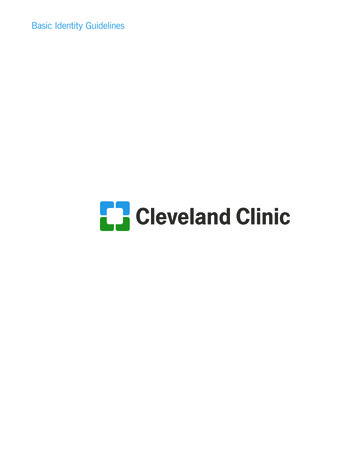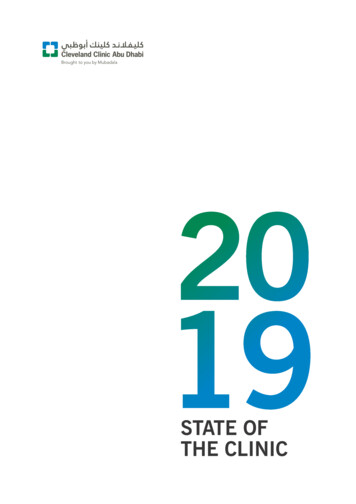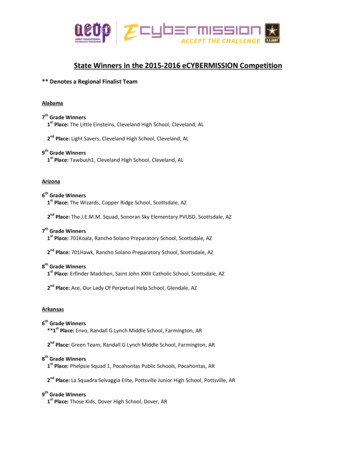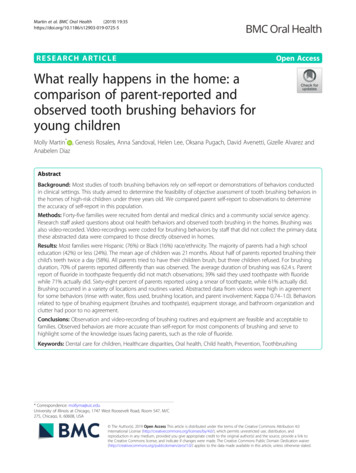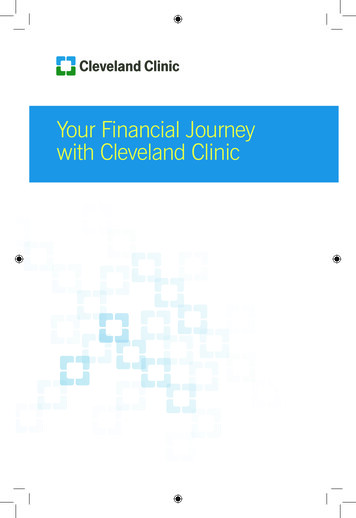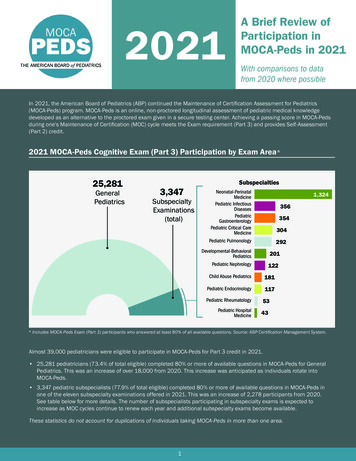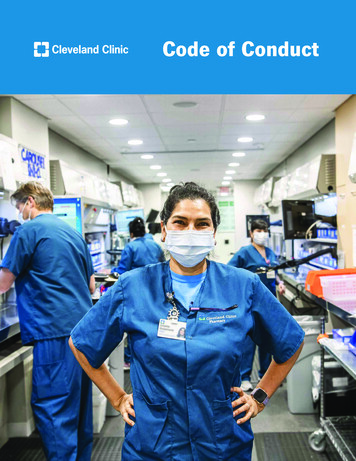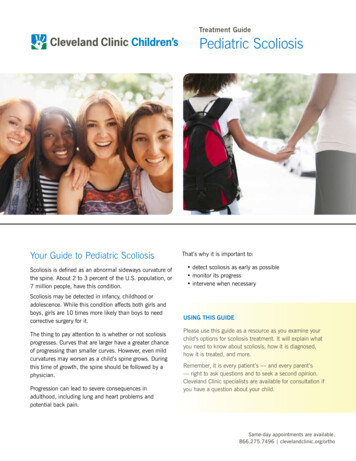
Transcription
Treatment GuidePediatric ScoliosisYour Guide to Pediatric ScoliosisScoliosis is defined as an abnormal sideways curvature ofthe spine. About 2 to 3 percent of the U.S. population, or7 million people, have this condition.Scoliosis may be detected in infancy, childhood oradolescence. While this condition affects both girls andboys, girls are 10 times more likely than boys to needcorrective surgery for it.The thing to pay attention to is whether or not scoliosisprogresses. Curves that are larger have a greater chanceof progressing than smaller curves. However, even mildcurvatures may worsen as a child’s spine grows. Duringthis time of growth, the spine should be followed by aphysician.Progression can lead to severe consequences inadulthood, including lung and heart problems andpotential back pain.That’s why it is important to: detect scoliosis as early as possible monitor its progress intervene when necessaryUSING THIS GUIDEPlease use this guide as a resource as you examine yourchild’s options for scoliosis treatment. It will explain whatyou need to know about scoliosis, how it is diagnosed,how it is treated, and more.Remember, it is every patient’s — and every parent’s— right to ask questions and to seek a second opinion.Cleveland Clinic specialists are available for consultation ifyou have a question about your child.Same-day appointments are available.866.275.7496 clevelandclinic.org/ortho
CLEVELAND CLINIC CHILDREN’S PEDIATRIC SCOLIOSIS TREATMENT GUIDEThere are three types of childhood scoliosis:1. Idiopathic scoliosis — Idiopathic scoliosis represents 80 percent of allscoliosis cases. It usually develops during adolescence, between ages 10 and16. Scoliosis that develops earlier can be defined as infantile (0-3 years) orjuvenile (4-10 years). The younger a scoliosis curve develops, the higher thechance that it progresses or worsens. Idiopathic means “of unknown cause” andscientists have not yet unraveled why scoliosis develops. But because idiopathicscoliosis runs in families, it has a genetic basis.2. Congenital scoliosis — Congenital scoliosis is a fairly rare bone abnormalitydetected at birth. The vertebral (spine) bones do not form normally and this canlead to scoliosis. Very often, it accompanies other birth defects, such as heartor kidney problems.3. Neuromuscular scoliosis — Neuromuscular scoliosis is caused byabnormalities in muscles and nerves that support the spine. Thus, patientswith muscular dystrophy, spina bifida and cerebral palsy are susceptible.Neuromuscular scoliosis can become quite severe.Scoliosis looks different in different people: It may be mild. It may be severe. It may involve a single, short “C” curve. It may involve a long, double or triple “S” curve.Progression (worsening)Idiopathic scoliosis may or may not progress. The two most important factorsinfluencing progression are the size of the curve and the skeletal growthremaining for the child. The younger a child is and the larger the curvature, themore likely the deformity will worsen. Fortunately, intervening at the right timecan prevent complications and ease symptoms.Identifying scoliosis earlyEarly detection and monitoring are very important to keep spinal curvaturesfrom progressing. Beginning at age 8 or 9, children are screened for scoliosis atannual checkups with their pediatricians.The pediatrician will examine your child for a difference in shoulder height, anuneven waistline or a prominence on one side of the back while standing.Thenyour child will be asked to do a “forward bend test,” bending down to touch hisor her toes. This is the best way for the pediatrician to see a prominence on oneside of the back.2Same-day appointments are available.866.275.7496 clevelandclinic.org/ortho
CLEVELAND CLINIC CHILDREN’S PEDIATRIC SCOLIOSIS TREATMENT GUIDEAny child who has an abnormal forward bend test result should be referred toa pediatric orthopaedic specialist, or expert on skeletal growth in children andadolescents. The pediatric orthopaedic specialist will perform an examinationand order X-rays of the spine. These will determine the degree of spinalcurvature as well as your child’s skeletal maturity.Typically, children with scoliosis need to visit the pediatric orthopaedicspecialist every six months. They will be examined and will have X-rays takento check how much or how little the curve is progressing.The pediatric orthopaedic doctor who monitors your child will let you knowwhen and if any intervention might be necessary. If the curve remains small,no treatment other than continued observation is needed.Options for managing scoliosisTreatments for scoliosis have advanced dramatically in the last 10 years.There are four options:1. Observation — Children who have idiopathic scoliosis and mild (10-to-25degree) curves only need to be monitored by pediatric orthopaedic specialists.They will be observed most carefully during their growth spurt in puberty, whenmost curvatures are likely to worsen.2. Bracing the spine — Children with further growth remaining and curvesof 25 to 45 degrees may benefit from wearing a brace, or orthosis. The braceapplies gentle pressure to the trunk and pelvis to keep the spine as straight aspossible while the child grows.Most braces are now custom-made, using plastic with padding, and aremolded to conform to the child’s trunk (the large metal “Milwaukee” braces area rare sight today). Some children with idiopathic scoliosis only need to weartheir brace at night.Every four to six months, X-rays are done to re-measure the child’s curve. Thedoctor will halt bracing when the child’s skeletal growth is complete, at whichpoint bracing no longer helps.For some children, bracing is a temporary measure until surgery can beperformed. For children with very large curves (more than 45 degrees), bracingis not helpful at all.Same-day appointments are available.866.275.7496 clevelandclinic.org/ortho3
CLEVELAND CLINIC CHILDREN’S PEDIATRIC SCOLIOSIS TREATMENT GUIDEMAGEC systemFor some children with severe early-onsetscoliosis, a new system called MAGEC (Magnetic Expansion Control) eliminates thefollow-up surgeries required for lengtheningtraditional growing rods. Instead, once theMAGEC rod is surgically implanted, it canbe lengthened noninvasively and painlesslyas the child grows, using magnetictechnology and a remote control in thedoctor’s office. Any child with scoliosis whois a candidate for traditional growing rods isa candidate for MAGEC as early as age 2.3. Traction — In rare cases, children with severe spinal curvaturesmay benefit from a period of “halo” traction. This usually involves ahospital stay. A ring is attached to the skull and increasing weightsare gradually applied to it as the patient remains mobile. This helpsto loosen the spine and stretch the muscles, arteries and nerves,resulting in better alignment and safer surgery. At advanced centerssuch as Cleveland Clinic, traction can sometimes be applied toyoung patients in wheelchairs and walkers so that they remainmobile.4. Surgery: Repositioning and fusing the spine — Surgery isconsidered for only a fraction of scoliosis patients. It is importantwhen bracing can no longer hold the scoliosis in check or whencurves are too large for bracing. The timing of surgery varies,depending upon the degree and type of curvature.Type of scoliosisBracing recommendationsIdiopathic scoliosisBracing may be helpful as the spine grows toprevent curves from worsening.NeuromuscularscoliosisBracing can improve sitting posture and trunkstability when children are in wheelchairs.Congenital scoliosisBracing is rarely helpful for these children, whotend to have large curves.Timing of surgery for large curvesFor adolescents, surgery is scheduled when thoracic (chest) curvesreach 45 to 50 degrees or when lumbar (waist) curves reach 40 to45 degrees despite bracing. Skeletal growth must be complete ornearly complete.For young children, surgery does not involve fusing the spine.Instead, a “growing rod” is surgically attached to the spine tostabilize it. This allows the chest and spine to grow almost tomaturity, when the spine is ready for permanent fusion.4Same-day appointments are available.866.275.7496 clevelandclinic.org/ortho
CLEVELAND CLINIC CHILDREN’S PEDIATRIC SCOLIOSIS TREATMENT GUIDEFusion surgeryFusion surgery for scoliosis involves joining together the bones, or vertebrae, ofaffected segments of the spine to realign it and halt curve progression. Surgeonstoday fuse the minimum number of vertebrae needed to correct a curve, andalmost always use a “posterior approach.”In posterior fusion, the spinal column is accessed from the back, and screws areplaced into the affected vertebrae. A short rod is then inserted into slots alongthe top of the screws. The surgeon gently moves the rods to correct the spine’salignment, then bolts the hardware in place. A bone graft is placed on top ofthe treated area to encourage bone healing. The end result: a much straighterspine and a sturdy correction.Recovery at homeBecause scoliosis presents in different patterns and degrees, other surgicalapproaches are available as well.Spinal fusions are major surgery. Soyour child may not feel like himselfor herself for three to four weeks. Byfour to six weeks, your child will beready to return to school.ApproachAdvantagePosterior(through the back)This approach, the most common, avoids the slightpotential risks of lung damage and achieves anexcellent result.Anterior(through the side)This approach is rarely used but may assist surgeons in repositioning the spine when curves arecomplex.Most children do not need bracingduring recovery. To allow the boneto heal, however, your child shouldavoid bending, twisting and liftinganything over 10 pounds. In sixmonths’ time, your child can startstretching and return to sports.At six months, they are free toresume all normal activities — evenriding roller coasters, water skiingand mogul skiing. However, heavycontact sports such as football andrugby are not recommended at anytime after spinal fusion.Combinedanterior-posteriorapproach(through thefront and side)The combined approach is rarely used, but mayassist with bone healing in complex cases.Thoracoscopicapproach(minimally invasive)This approach is rarely used, but inserting a“scope” through the chest may help surgeons toloosen very large, complex curves. It causes lessscarring than anterior fusion, but typically posteriorfusion is still needed afterward.Same-day appointments are available.866.275.7496 clevelandclinic.org/ortho5
CLEVELAND CLINIC CHILDREN’S PEDIATRIC SCOLIOSIS TREATMENT GUIDEChild Life SpecialistsChildren’s hospitals such asCleveland Clinic also havespecial pediatric social workerscalled child life specialistswho are experts in child andadolescent development. Theycan help the family understandwhat to expect and how to copewith the stresses of surgery andhospitalization.Managing children’s pain and other needsCleveland Clinic Children’s and similar centers have pediatric anesthesiologistson staff. They are adept at managing children’s anesthesia, and will providegeneral anesthesia for spine surgery. Large centers like ours also have aneurological team to monitor spinal cord function minute-by-minute during theentire procedure.After surgery, pediatric anesthesiologists make sure that each child’s pain iswell-controlled. They may provide epidural anesthesia or prescribe patientcontrolled analgesia (PCA). Patients using PCA can “pump” safe doses of painmedicine through an intravenous line when they need it.Your child’s hospital stayMost hospital stays for scoliosis fusions are three days, but some may last up toa week. Your child will spend the first night in the intensive care unit and willthen move to a hospital floor. Physical therapy will begin the day after surgery,when your child will be getting out of bed on his or her own.Thanks to early therapy, your child will be able walk through the hospital doorsat discharge. At home, he or she will be able to walk around the house, climbthe stairs and go outside.6Same-day appointments are available.866.275.7496 clevelandclinic.org/ortho
CLEVELAND CLINIC CHILDREN’S PEDIATRIC SCOLIOSIS TREATMENT GUIDEFrequently asked questionsOur experts provide answers to some of the most commonconcerns they hear from children and teenagers:Why did I get scoliosis?You did not do anything wrong that caused scoliosis.Scoliosis is a genetic condition, but scientists do not yetunderstand the exact cause. It can be congenital (bonesformed abnormally) or neurological (from a disorder likecerebral palsy).Can you predict if my scoliosis is going to get worse?Not all cases of scoliosis progress (get worse). The youngeryou are and the larger your curvature, the more likely thescoliosis will get worse.What position do I need to sleep in?You can sleep in any position that is comfortable.Can I still exercise?Definitely. Exercise is important to staying healthy.Your activities will not make your scoliosis worse.Who has to wear a brace?Your doctor may recommend you wear a brace temporarilyto keep your curve from getting worse during a growthspurt. The braces are lightweight and usually only need tobe worn at night.Will the brace make my scoliosis better?Some studies show that bracing will keep some curvesfrom getting bigger and requiring surgery. But some curveswill go back to normal once the brace is no longer worn.More research is needed to figure out how and whenbracing is the best option.How should I choose a surgeon?We know it can be a major decision to pick a surgeon foryour care, especially if you have to travel. Talk to yourprimary care physician and orthopaedic specialist, andcarefully research any potential surgeons online. You willwant to pick a doctor who is experienced and performs alarge number of pediatric and adolescent scoliosis surgerieseach year. Consider their training and the hospital’soutcomes.How soon after surgery can I walk again?You can begin walking again as soon as you arecomfortable. This is typically the first day after surgery.How long will I be in the hospital?Three days is the average. But it may be a bit more or less,depending upon how you are doing.How much school will I miss?Up to six weeks, but some children and adolescents areready to return to the classroom in as little as three weeks.After surgery, is there anything I won’t be able to do?Once you leave the hospital, you can return to your normalactivities at home. You should avoid bending, lifting morethan 10 pounds and twisting your torso for the first sixmonths. Your doctor may clear you to return to sports atabout six months.Will I need more surgery in the future?Additional surgeries are not often needed. Follow up withyour surgeon for up to five years after your surgery to makecertain your spine heals correctly.How do I know if I need surgery?Not everyone needs surgery for scoliosis. Your doctor mayrecommend it if bracing can’t hold your scoliosis in checkanymore, or if your curve is too large for bracing. He orshe will discuss the best timing for surgery with youand your family.Same-day appointments are available.866.275.7496 clevelandclinic.org/ortho7
CLEVELAND CLINIC CHILDREN’S PEDIATRIC SCOLIOSIS TREATMENT GUIDEBusting Scoliosis MythsMyth: You can tell someone has scoliosis by their hump.Fact: Scoliosis always produces a hump on the ribs, but the size of the humpdepends on how much the spine curves and rotates. The spine tends to rotatetoward the direction to which it curves. The ribs on the same side of the curvethen get pushed backward. A large curve will push the ribs out dramaticallyon one side of the chest. A small curve may be barely visible. In fact, somepeople live their entire lives without realizing that they have mild scoliosis.Being aware of scoliosis means it is important to monitor progression.Myth: Alternative therapy can cure scoliosis.Fact: Acupuncture, chiropractic therapy, physical therapy and electricalstimulation have been touted as alternative therapies for scoliosis, but theydo not affect the progression of the curve. Curves that progress beyond 45 to50 degrees should be treated to avoid severe consequences. Surgery is theonly way to permanently realign the spine; even bracing can only halt curveprogression at best. That said, alternative therapies may relieve some patients’discomfort. And stretching and staying fit are always important for overallhealth and well-being.Myth: You can’t bend over after a spinal fusion.Fact: Not only is it possible to bend over after a spinal fusion — some patientsare even able to touch their toes and get into a tuck position. Contrary topopular opinion, we don’t just bend from the waist. We bend from the hips,which are unaffected by surgery. Fused areas of the spine will have lessmobility, but surgery will not greatly affect your overall mobility.8Same-day appointments are available.866.275.7496 clevelandclinic.org/ortho
CLEVELAND CLINIC CHILDREN’S PEDIATRIC SCOLIOSIS TREATMENT GUIDEMeet Our Scoliosis SpecialistsTo make an appointmentRyan C. Goodwin, MDDirector, Center for Pediatric Orthopaedic SurgeryDirector, Assistant Residency Programwith one of our scoliosisSpecialty Interests: Pediatric orthopaedics, pediatric andadolescent hip disorders, hip arthroscopy, scoliosis andspinal deformity, pediatric orthopaedic trauma866.275.7496specialists please callDavid Gurd, MDDirector, Pediatric Spinal DeformitySpecialty Interests: Pediatric, adolescent and youngadult spinal surgery; scoliosis; kyphosis;spondylolysthesis; pediatric orthopaedicsThomas E. Kuivila, MDVice Chair for Education,Orthopaedic & Rheumatologic InstituteDirector, Orthopaedics Residency ProgramSpecialty Interests: Pediatric, adolescent and youngadult spinal surgery, including scoliosis surgery;pediatric orthopaedic traumaSame-day appointments are available.866.275.7496 clevelandclinic.org/ortho9
Contacting Cleveland ClinicConnect with Cleveland ClinicReady to schedule an appointment? To make an appointmentwith a scoliosis specialist at Cleveland Clinic, call216.444.2606 or 866.275.7496.Get wellness tips, healthy gourmet recipes, essential healthnews and free downloadable health guides straight to yourinbox. Sign up today at clevelandclinic.org/bewell.Need a second opinion?Like us on Facebook at facebook.com/clevelandclinicOur MyConsult service offers secure online second opinionsfor patients who cannot travel to Cleveland. Through thisservice, patients enter detailed health information andmail pertinent test results to us. Then, Cleveland Clinicexperts render an opinion that includes treatment optionsor alternatives and recommendations regarding futuretherapeutic considerations. To learn more about MyConsult,please visit clevelandclinic.org/myconsult.Explore our services, locations and more atclevelandclinic.orgFind a wealth of family health and wellness tips athealth.clevelandclinic.org.MyChartCleveland Clinic’s MyChart is a secure, online tool thatconnects you to portions of your electronic medical recordfrom the privacy of your home. Utilize this free service tomanage your healthcare at any time, day or night. WithMyChart you can view test results, renew prescriptions,request appointments and more. You can also manage thehealthcare of your loved ones with MyChart Caregiver. Toregister or learn more, log on to clevelandclinic.org/mychart.15-ORT-2608
Typically, children with scoliosis need to visit the pediatric orthopaedic specialist every six months. They will be examined and will have X-rays taken to check how much or how little the curve is progressing. The pediatric orthopaedic doctor who monitors your child will let you know when and if any intervention might be necessary.
